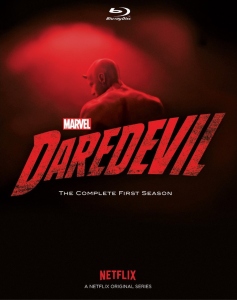In retrospect, I was destined to be a huge “Daredevil” fan before finally getting around to watching Season 1 (2015, Netflix) of this Marvel Cinematic Universe series. Frank Miller’s 1980s comics that redefined Daredevil into a grim vigilante heavily influenced Eastman & Laird’s invention of one of my favorite comics: “Teenage Mutant Ninja Turtles.” Splinter comes from Stick, the Foot comes from the Hand, and the same ooze that gives Daredevil his heightened senses mutates the Turtles.
Shades of ‘TMNT’ and ‘Buffy’
And there are more subtle similarities. Music that calls to mind the 1990 “TMNT” movie. Matt Murdock/Daredevil (Charlie Cox) yanking an enemy around a corner from off-screen. And the visuals — my god, the visuals. Hell’s Kitchen – portrayed by real NYC neighborhoods – is replete with rain, neon signs, rooftops, alleys, wet streets and old apartments. I can see the location-shoot money on every inch of the screen.
The production doesn’t skimp on talent either, from a masterful Vincent D’Onofrio as crime kingpin Wilson Fisk to Vondie Curtis-Hall as a grizzled newspaperman, to Toby Leonard Moore and his authoritative voice as Fisk’s reliable second-in-command.

“Daredevil” Season 1 (2015)
Netflix, 13 episodes
Creator: Drew Goddard
Stars: Charlie Cox, Vincent D’Onofrio, Deborah Ann Woll
Cox is a tremendous as a blind man who has adjusted to his condition, acting without his eyes. Eldon Henson’s Foggy and Deborah Ann Woll’s Karen round out a trio similar to “Angel,” except they are a law firm of do-gooders rather than a detective agency of do-gooders. Their utilitarian office is even less stylized than Angel’s, emphasizing “Daredevil’s” interest in gritty realness.
The Buffyverse connection is prominent behind the scenes, as well. Drew Goddard is the showrunner, and the staff includes Douglas Petrie and Steven S. DeKnight, not to mention Christos Gage from Buffyverse comics.
While “Daredevil” could arguably be enjoyed on its own, I do think it gains something substantial from being part of the MCU. In two cases, the show introduces otherworldly elements, and no explanation is needed, since we already know the supernatural is part of the MCU.
A Japanese crime syndicate holds a young boy who Stick believes is a supernatural weapon. Later, Gao – one of Fisk’s business partners – announces that her homeland is “a considerable distance farther” than China, suggesting she might be an alien.
The quality of Season 1 is so consistently high that it’s hard to rank the episodes, but here goes:
1. “Stick” (episode 7, written by Douglas Petrie)
I was in the tank for this episode before it began, having always been curious about Matt’s mentor, knowing that “TMNT’s” Splinter was an homage to him. Whereas Splinter shows a degree of love for his surrogate sons, Stick (Scott Glenn) is a curmudgeon who aims to turn young Matt (Skylar Gaertner) into a weapon. Still, we learn that he has kept the bracelet Matt had given him, so maybe his heart isn’t pure ice.

2. “Daredevil” (13, Steven S. DeKnight)
The grand finale features iconic payoff moments such as Matt donning the costume and Fisk staring at the white wall of his cell (mirroring how his father made him stare at a wall, and the art he purchases for his bedroom as an adult). But the episode takes clever twists and turns.
While Fisk killing his accountant Leland is one of those “Oh crap, he’s gonna kill him” scenes, I love how it’s the first domino in a string of events that get Fisk collared. The montage of FBI agents arresting everyone on the crime lord’s payroll is cathartic, but then DeKnight reminds us it’s not that easy – Fisk’s reach extends beyond Hell’s Kitchen, and he escapes custody. Appropriately, Daredevil tracks him down in an alley and ends it with one last vicious fistfight.
3. “Shadows in the Glass” (8, DeKnight)
Two words: Fisk’s backstory. Here we see how his abusive dad – whom young Wilson beats to death with a hammer – has shaped Fisk, from skills in brute violence to a need to control and shape things. It’s often said that the best villains think they are the heroes of the piece, but Fisk is more interesting: Yes, he thinks he’s the hero, but he wavers. Expressions on his face are often variations of his quote from this episode: “I’m not a monster. … Am I?”
4. “Into the Ring” (1, Drew Goddard)
I like how the narrative mixes the familiar origin story of Matt (getting a spilled chemical in his eyes after saving a man from a truck crash), the backstory of his powers (which, in a nutshell, is radar-sense), and the present-day story where he, Foggy and Karen form a law firm.
5. “The Ones We Leave Behind” (12, Petrie)
While Karen’s killing of Wesley in the previous episode subverts expectations, most of the time when someone is in Fisk’s crosshairs, we feel dread. Here, it’s “Oh crap, Ben’s gonna get killed, isn’t he?” The answer is yes, but in his parting episode the reporter gets in a nice jab at his editor about modern journalism: “Most of the time now working for this paper, I might as well be wearing lipstick and a red dress.”
6. “The Path of the Righteous” (11, DeKnight and Petrie)
Almost always when an innocent character gets hold of a gun in a meeting with an experienced criminal, it’s a fleeting moment of false hope. In a nice subverting of expectations, Karen succeeds in killing Wesley, an act she’ll struggle with from this point forward. Before that, “Path” is a showcase for smaller stuff like Foggy and Karen commiserating in Josie’s bar as the Heartless Bastards’ “Only For You” plays in the background.
7. “Cut Man” (2, Goddard)
Three words: The hallway fight. It’s my favorite action sequence of the season. Matt wades into a basement lair of a bunch of professional thugs who are holding a child hostage, beats the hell out of them and walks away with the kid in his arms.
This is wish-fulfillment: We all like to think we could wade through the world’s evil obstacles with brute determination and make things right. But “Daredevil” never loses its tether to reality: Matt is limping on the way out, and he very much needs nurse Claire (Rosario Dawson) to patch him up after fights like this.
8. “In the Blood” (4, Joe Pokaski)
The Big Bad is smartly introduced as we see the contrast between the emotionally vulnerable Fisk on a date with high-class art dealer Vanessa, and later see him viciously decapitating an underling with a car door. It was already clear that this is an R-rated show, but this scene is so violent it makes the MCU movies seem like they should be G-rated.
9. “Nelson v. Murdock” (10, Luke Kalteux)
No, Cox and Henson don’t look like college students in the flashbacks, but I nonetheless enjoy seeing how Matt and Foggy are genuine friends from the get-go. As dark as “Daredevil” can get, the human relationships are rays of light. In the present day, Foggy — irked that Matt has kept his superhero identity from him for years – angrily asks whether Matt is any different from Fisk. But Gao illustrates the crux of the difference when speaking to Fisk: “Man cannot be both savior and oppressor. Choose. Choose wisely.”
10. “Rabbit in a Snowstorm” (3, Marco Ramirez)
Through grizzled but supremely ethical New York Bulletin reporter Ben Urich, “Daredevil” begins its spot-on portrayal of modern newspapers. He argues with his editor about the paper’s policy of prospective circulation determining story selection, something I see in my own job (except with web clicks having supplanted circulation as the most valued metric).
Ben is on my short list of great fictional newsmen. Meanwhile, Fisk is scary before we even meet him, as illustrated when an underling kills himself after giving up Fisk’s name to Matt.
11. “Speak of the Devil” (9, Christos Gage and Ruth Fletcher Gage)
To give an idea of how slow-burning this show is, episode 9 features the first in-person meeting between Matt and Fisk. Matt’s fight against the ninja Nobu nicely illustrates the less overt “TMNT” parallels that make this show catnip for me, as some of John Paesano’s music is reminiscent of the first “TMNT” film.
But mostly this hour wades into Matt’s internal struggle, as outlined in his conversations with his priest, who frames the struggle in an intriguing way: Does Matt regret having to kill, or does he hate himself for wanting to kill?
12. “World on Fire” (5, Kalteux)
The narrative starts to decompress at this point, as we learn details about Fisk’s schemes for urban renewal. An elderly Hispanic woman named Elena is the personification of how Fisk’s “greater good” strategy of driving tenants out of their homes has real victims. The title refers to Matt’s description of what he “sees” in his mind’s eye – it might be hyperbole, but it fits well with this superhero.
13. “Condemned” (6, Pokaski and Ramirez)
This episode illustrates Fisk’s incredible reach; he’s Darth Sidious on the scale of Hell’s Kitchen. Matt declines Fisk’s offer to end their ongoing war, but the crime lord isn’t worried about the next step, telling Wesley “I’ll let the police do their jobs. That’s what I pay them for.” Cornered in an old warehouse, Matt’s reluctance to kill his enemies is emphasized; it initially seems a bit forced. It’s also getting quite funny to think that Foggy and Karen don’t know his real identity.
What are your favorite episodes of “Daredevil” Season 1? Share your thoughts below.


It’s been a while since I watched this season so it’s fun to relive it through your review. I remember watching ep 11 (the meeting with Matt and Fisk) and turning to my wife in awe and just saying “man, the tension is so incredible”… DD season 1 set a high bar for the Netflix Marvel shows and though they have faltered a bit, most are strong. I’m excited to hear what you think of the others!
I agree. The meticulous crafting by the writers leads to serious tension when Fisk and Matt square off in episode 9. “Daredevil” Season 1 is a masterpiece. “Jessica Jones” Season 1 is also smartly written, but in my opinion it tends toward plodding rather than intense toward the back half of the season, like they are padding it out a bit to reach 13 episodes. There’s also a sense of inevitability that it will end with a Jessica-Kilgrave showdown. With “Daredevil, ” I rarely feel like I know precisely where it is going. Maybe in specific scenes, but certainly not in the overall season arc. That having been said, I’m glad it concludes with what is arguably a predictable alley fight between Fisk and Matt. It is an appropriate and satisfying conclusion. When your stunt and action work is that good, you can get a way with a bit of fan service.